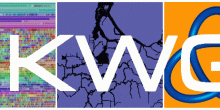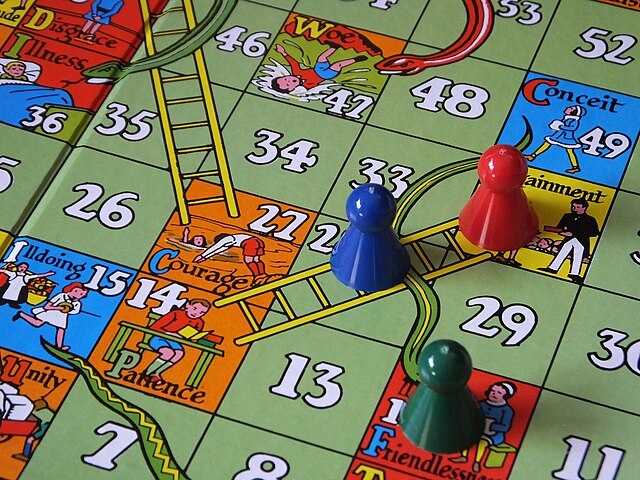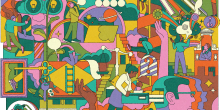Since 2019 the NETWORKS program has been offering a workshop on popular science writing together with Analytic Storytelling. Twelve mathematicians doing research within NETWORKS participate every year. During the workshop, they receive guidance on writing an article for the Network Pages on a topic related to networks, algorithms, probabilities, applications of mathematics, or whatever intrigues them.
Many articles you have read on the NetworkPages were written during one of the workshops. I participated in the first workshop in 2019. Each workshop consists of three half-day sessions where you see your article taking shape and being created. I remember vividly that in the first session we were asked to make a concrete profile of our intended readers. We started with this article from the Guardian, about readers' profiles.

YouGov Guardian Customer Profile Photograph: YouGov. Taken from the article in the Guardian.
Since none of us had experience with journalism and popular science writing, it took some time to form a concrete idea of our target audience, and how to write the articles according to their interests and background. This made it even more surprising to see that existing magazines and newspapers go so deep with their readers' profiles!

YouGov Guardian Customer Profile Photograph: YouGov. Taken from the article in the Guardian.
During the first session, we also discussed with each other which aspects of our topics were interesting for our intended audience. After the session, the writing started! In the weeks following the first session you mostly spend time thinking about your topic and how to present it, and also reading a first draft version of the article of other participants. Reading and commenting on each other's work is an essential aspect of the workshop. And also part of the fun because you see also your colleagues articles being created!
In the second and third sessions, most attention is paid to writing techniques and discussing the articles with the group. The sessions are spread over two months, and in this time you can see your work converging to an article you are happy and satisfied with! In that first workshop, Bart Jansen wrote How to plan Valentine’s day using a matching algorithm, Remco van der Hofstad wrote How the popular become even more popular, and Richard Post wrote Drugs dumping in the Netherlands; a gentle introduction to uncertainty and statistics.
Writing is an amazing process, you start with an idea and you have to think thoroughly about how to structure it and present it in an accessible and appealing manner. It is a very personal process. Sometimes I forget that language plays an important role in doing mathematics. It is not just about the formulas. Mathematics is a very creative discipline, where you need to come up with solutions to problems and puzzles. But the process of explaining mathematics, even to yourself, is also a very creative process where language plays an essential role.
Three years later
At the moment I am writing this post the autumn workshop is being held. Six colleagues are currently thinking about their stories and how to communicate their enthusiasm with the readers of the Network Pages. In 2020 NETWORKS received the COFUND grant from the Horizon 2020 program for 14 Ph.D. positions and 14 postdoctoral researchers for 2 years. COFUND gave a boost to the research done within NETWORKS, but also to the workshops Analytic Storytelling.
One aspect of COFUND is that the people hired in it should also work on outreach and promoting their research to a broader audience. This allowed us to double the number of workshops we offer each year, this year we will be offering four writing workshops! You know what this means, this year there will be many fascinating and interesting articles appearing on the Network Pages!
Writing tips
Together with Arnaud Bom from Analytic Storytelling, we decided to promote some of the articles on the Network Pages because of the creative writing techniques the authors used. We want to share these writing tips with you so that you can apply them in your writings!
First tip (written by Arnaud Bom): connect your topic to something concrete. Something your audience knows.
In this article, Lucas van Kreveld explains the concept of stationary distribution using the concrete example of a shared bicycles company. In a city with a station, a market, and a zoo. In the beginning of his article he asks himself:
"How is it possible that bikes are so perfectly spread out that they are available from almost anywhere? Who are these bike fairies that distribute them evenly across the city? Continue reading if you like to find out who they are and what type of mathematics is involved."
Is your subject also abstract and you want to explain it in an accessible way? Then find a concrete example your audience can relate to!
This technique is also used in the article of Nelly Litvak, who starts her article as follows:
"A brand new solution to an old mathematical problem. This time we found it by throwing in some negative cash, the debt."
Nelly used cash to explain the mathematical concept of a stationary distribution, and used the concept of debt to explain how the algorithm they developed works, and why it helps give a new solution to an old mathematical problem!
Second tip (also written by Arnaud Bom). A popular science article begins like this:
"[…] imagine a company of drunken students who wander in the streets, and whenever they come to an intersection one of them just spins around and they all go down the path that ends up being in front of the spinning student's eyes."

In this way, the author, Oliver Nagy, makes the mathematical concept of a 'random walk' concrete. That is an arbitrary route in a network. Random walks are used, among other things, to describe stock prices and the distribution of pollen.
Is your subject also abstract and do you communicate with a wide audience? Then a concrete metaphor helps a lot.
Only: how do you come up with that?
Usually, it helps to articulate the underlying idea first.
In Oliver's case: sequential, random moves on the nodes of a network.
Then brainstorm where you encounter that idea in a familiar sensory setting.
Streets and intersections make the network physical in a logical way. And a walk of a drunken company is a beautiful depiction of a random walk.
The metaphor allows Oliver to quickly explain later what a distribution is (places where the students can be and the probability that they are indeed there) and mixing time (the time that elapses until it no longer matters to the distribution what the starting point – the pub - used to be).
Well done!
Cherry on the cake
Maybe you have noticed something in the three writing techniques above: all three techniques are used to explain the same mathematical concept! Namely, what a stationary distribution is! But all three articles discuss it from different perspectives and present different results. Lucas presents a mathematical formula for the stationary distribution, Nelly discusses an algorithm to compute it, and Oliver relates it to the mixing time of a group of drunken students who walk in a surrealistic city where dancing streets and night buses govern the math. Hence, the final writing tip, there are many ways to discuss an abstract concept, let your creativity come up with one that inspires you.
Featured Image from David Schwarzenberg via Pixabay.







